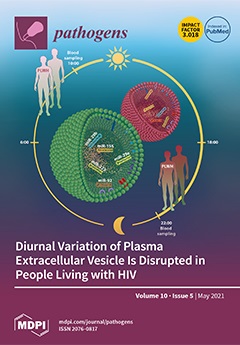Ver ítem
- xmlui.general.dspace_homeCentros Regionales y EEAsCentro Regional CorrientesEEA MercedesArtículos científicosxmlui.ArtifactBrowser.ItemViewer.trail
- Inicio
- Centros Regionales y EEAs
- Centro Regional Corrientes
- EEA Mercedes
- Artículos científicos
- Ver ítem
Distribution and Severity of Placental Lesions Caused by the Chlamydia abortus 1B Vaccine Strain in Vaccinated Ewes
Resumen
Chlamydia abortus infects livestock species worldwide and is the cause of enzootic abortion of ewes (EAE). In Europe, control of the disease is achieved using a live vaccine based on C. abortus 1B strain. Although the vaccine has been useful for controlling disease outbreaks, abortion events due to the vaccine have been reported. Recently, placental pathology resulting from a vaccine type strain (vt) infection has been reported and shown to be similar to
[ver mas...]
Chlamydia abortus infects livestock species worldwide and is the cause of enzootic abortion of ewes (EAE). In Europe, control of the disease is achieved using a live vaccine based on C. abortus 1B strain. Although the vaccine has been useful for controlling disease outbreaks, abortion events due to the vaccine have been reported. Recently, placental pathology resulting from a vaccine type strain (vt) infection has been reported and shown to be similar to that resulting from a natural wild-type (wt) infection. The aim of this study was to extend these observations by comparing the distribution and severity of the lesions, the composition of the predominating cell infiltrate, the amount of bacteria present and the role of the blood supply in infection. A novel system for grading the histological and pathological features present was developed and the resulting multi-parameter data were statistically transformed for exploration and visualisation through a tailored principal component analysis (PCA) to evaluate the difference between them. The analysis provided no evidence of meaningful differences between vt and wt strains in terms of the measured pathological parameters. The study also contributes a novel methodology for analysing the progression of infection in the placenta for other abortifacient pathogens.
[Cerrar]

Autor
Caspe, Sergio Gaston;
Palarea-Albaladejo, Javier;
Underwood, Clare;
Livingstone, Morag;
Wattegedera, Sean Ranjan;
Milne, Elspeth;
Sargison, Neil Donald;
Chianini, Francesca;
Longbottom, David;
Fuente
Pathogens 10 (5) : 543 (April 2021)
Fecha
2021-05
Editorial
MDPI
ISSN
2076-0817
Formato
pdf
Tipo de documento
artículo
Palabras Claves
Derechos de acceso
Abierto
 Excepto donde se diga explicitamente, este item se publica bajo la siguiente descripción: Creative Commons Attribution-NonCommercial-ShareAlike 2.5 Unported (CC BY-NC-SA 2.5)
Excepto donde se diga explicitamente, este item se publica bajo la siguiente descripción: Creative Commons Attribution-NonCommercial-ShareAlike 2.5 Unported (CC BY-NC-SA 2.5)


